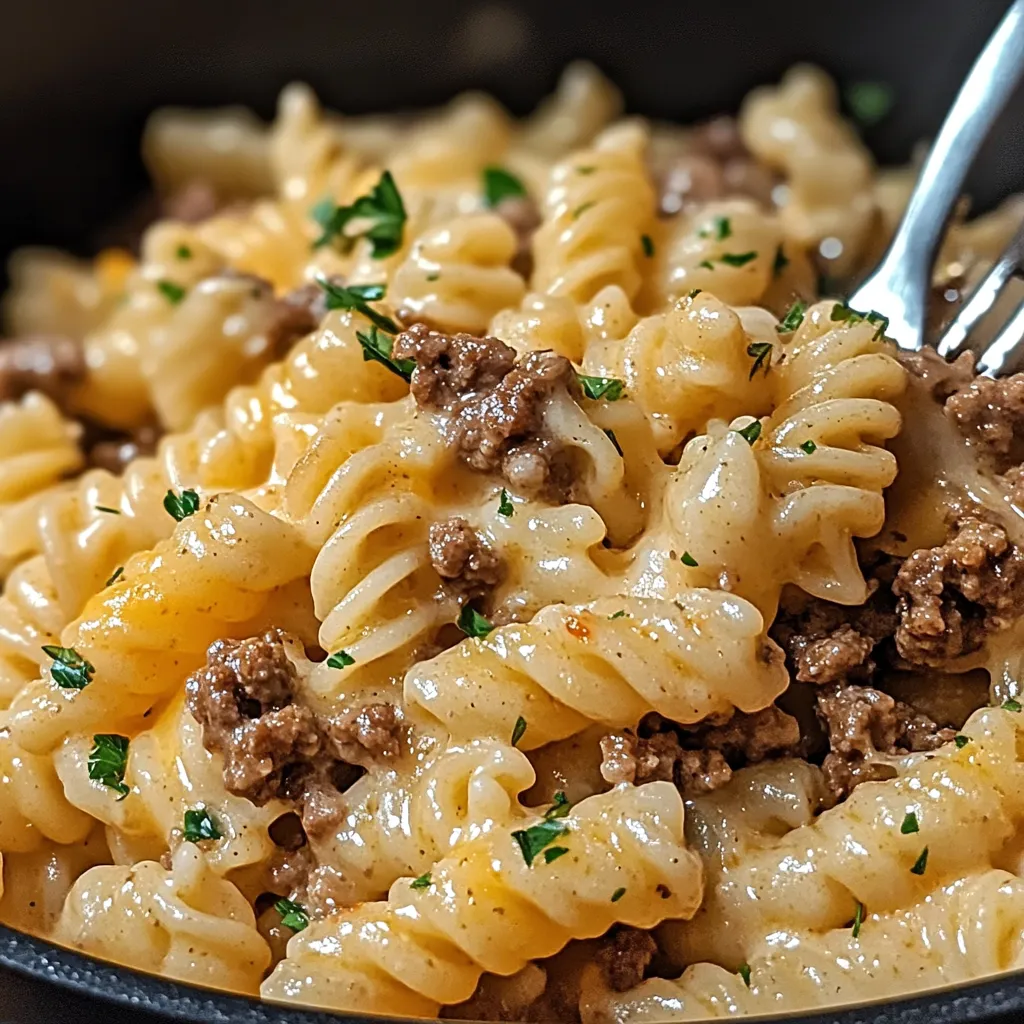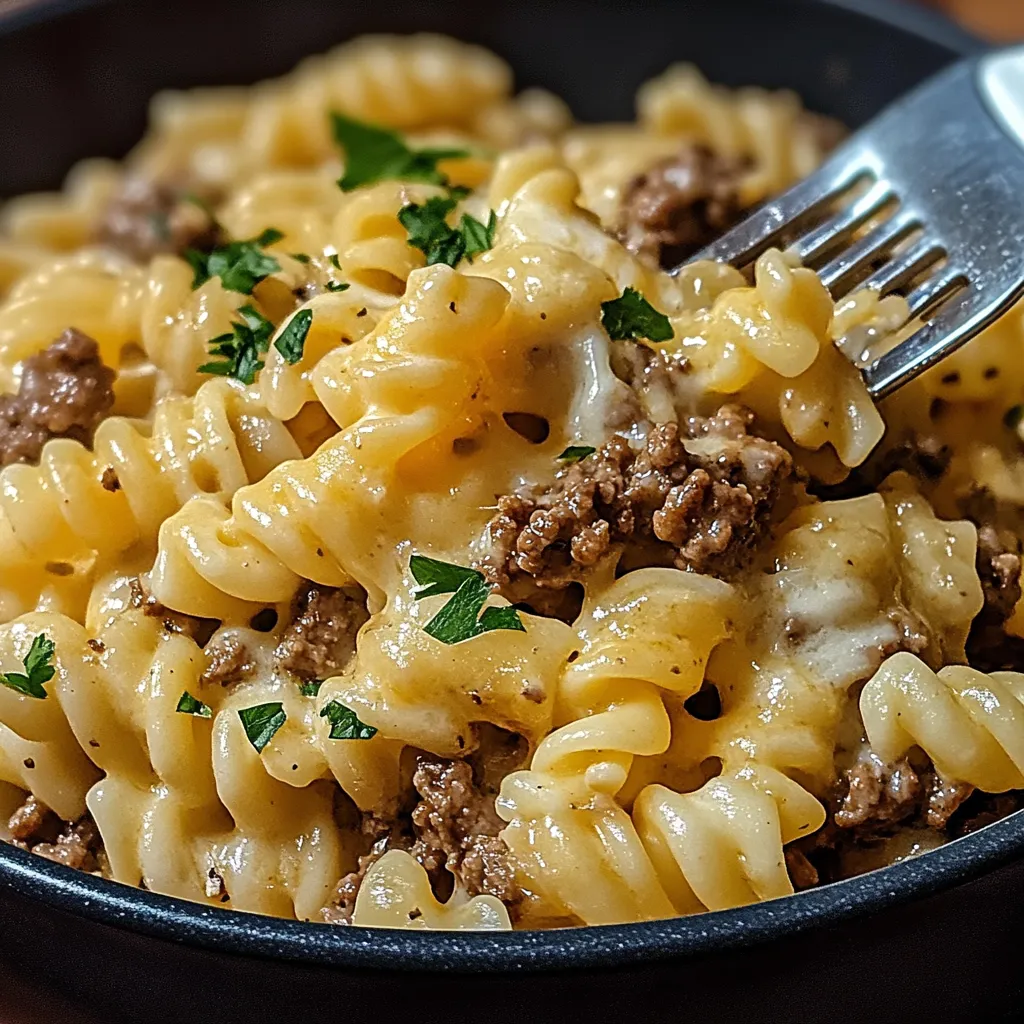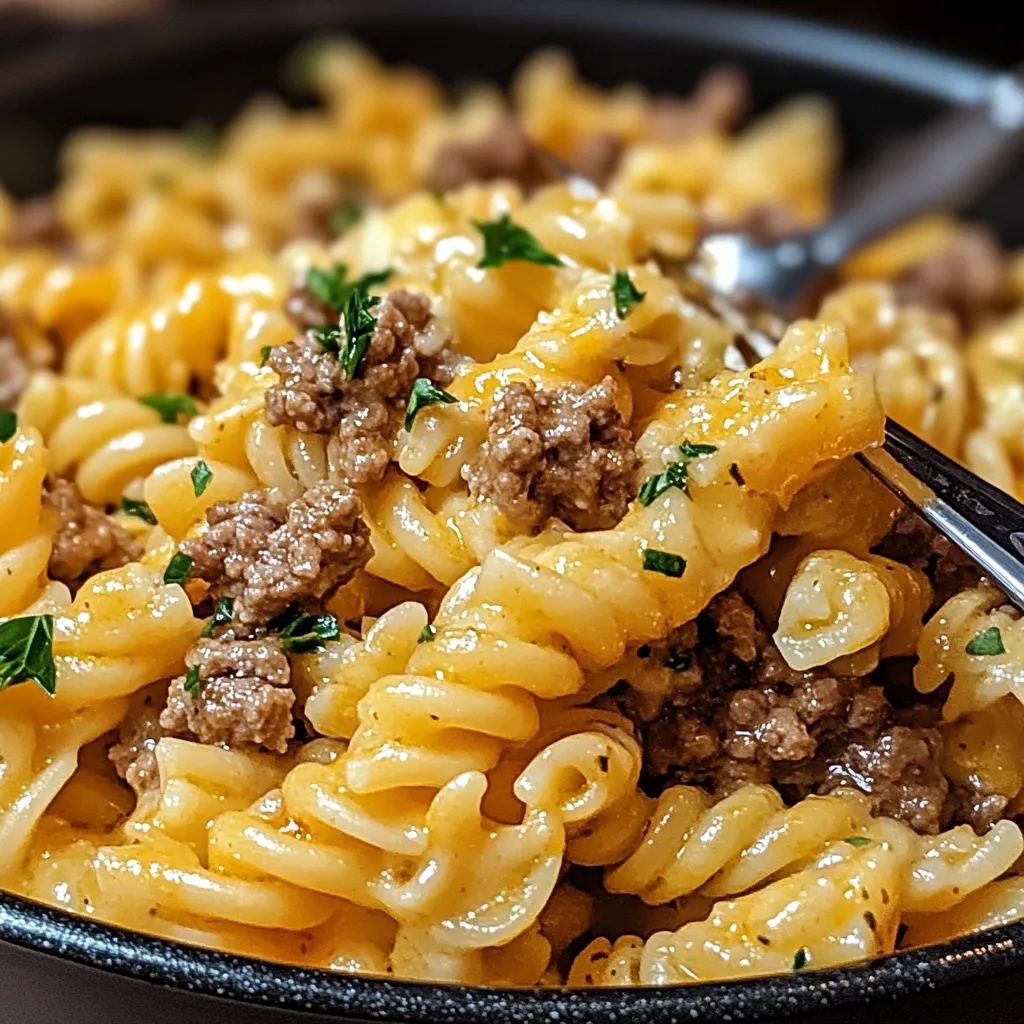 Save
Save
Single-pot beef and cheddar ranch pasta brings amazing comfort with hardly any work, mixing soft pasta, tasty ground beef, and a smooth cheddar-ranch sauce that wraps around every bite. This dinner hero turns basic pantry items into a deeply filling meal without messing up loads of pans or needing fancy tricks. The best part? The pasta cooks right in the seasoned broth, soaking up all those yummy flavors while letting out starches that naturally make the sauce thicker. The end result hits that sweet spot between creamy and filling – hearty enough for super hungry folks yet totally comforting for everyone sitting at your table.
I came up with this dish during a super busy week when I wanted something filling but couldn't deal with another mountain of dirty dishes. What started as kitchen desperation has turned into one of our family's most requested meals. My husband, who usually goes for classic Italian pasta dishes, asked for this three nights straight after my first try. Even my sister, who says she doesn't like ranch flavoring, went back for more and then wanted to know how to make it. There's something almost magical about how these basic ingredients change when they cook together.
Tasty Ingredients
- Pasta shapes: Mid-sized types with grooves or holes catch the sauce best; shells, twists, or tubes give you the perfect sauce-to-pasta balance
- Ground beef: Makes the hearty base of the dish; 85/15 meat-to-fat mix gives the best taste without too much grease
- Cheddar cheese: Adds the melty richness that's key to the sauce; sharp or extra-sharp kinds pack the most cheese punch
- Ranch seasoning: Gives that special herby, tangy flavor that makes the whole dish pop; store-bought packets work great
- Chicken broth: Creates the tasty liquid where the pasta cooks; pick low-sodium types to manage salt levels
- Milk: Brings creaminess and helps make the silky sauce; whole milk gives the richest results but 2% works too
- Butter: Sets a rich base for cooking and adds subtle depth to the final sauce; unsalted lets you control the seasoning better
- Yellow onion: Offers sweet aromatics that build the flavor foundation; chopping it small helps it blend into the sauce
- Fresh garlic: Adds essential depth of flavor; fresh cloves taste way better than the pre-minced stuff
- Salt and pepper: Basic seasonings that lift all other flavors; adjust based on how salty your broth is
Cooking Steps
- Meat preparation:
- Start by warming a large, heavy Dutch oven or deep pan over medium-high heat. Drop in two tablespoons of butter and let it melt fully. Add one pound of ground beef, breaking it into tiny bits with a wooden spoon. Sprinkle with half a teaspoon each of salt and fresh black pepper. Let it cook without touching for 2-3 minutes to get a nice brown crust before mixing and cooking until no pink shows, about 5-7 minutes total.
- Aromatics foundation:
- Keep the beef in the pot and add one finely chopped medium yellow onion. Mix it with the meat and cook for 3-4 minutes until the onion turns see-through and gets soft. Toss in three minced garlic cloves and cook just 30-60 seconds until you can smell them, being careful not to brown the garlic which can make things taste bitter.
- Flavor building:
- Shake one packet (about 2 tablespoons) of ranch seasoning over the beef mix, stirring well to spread the herbs and spices all through the meat. Let this cook about a minute, which wakes up the dried herbs and makes their flavors stronger while coating the beef with seasoning.
- Liquid addition:
- Pour in three cups of chicken broth and one cup of milk, stirring hard while scraping the bottom to get any stuck brown bits loose. These bits have concentrated flavors that add depth to your finished meal. Bring everything to a gentle bubble, changing the heat as needed.
- Pasta incorporation:
- Drop eight ounces of dry pasta straight into the bubbling liquid, mixing well so all pieces get covered. The pasta will cook right in the flavorful broth, soaking up those savory elements while letting out starches that naturally thicken the sauce. Bring the mix back to a simmer, then lower heat to medium-low.
- Gentle cooking:
- Cover the pot and keep a gentle simmer for 8-10 minutes, taking the lid off to stir thoroughly every 2-3 minutes so nothing sticks and everything cooks evenly. The pasta should be just a bit firmer than al dente when you move to the next step, as it'll keep cooking with the cheese.
- Cheese integration:
- Turn heat to low before adding two cups of shredded sharp cheddar cheese in three separate batches, stirring completely between each to help it melt smoothly. This step-by-step approach stops the cheese from clumping or making the sauce grainy. The leftover heat will melt the cheese while the starches from the pasta help create a silky smooth sauce.
- Final adjustments:
- Let the pasta sit for 2-3 minutes after adding the cheese, during which time the sauce will thicken to just the right texture. Taste and add more salt and pepper if needed. If the sauce seems too thick, splash in a bit more milk or broth; if too thin, let it cook uncovered for another minute or two.
Plating Ideas
Dish up right away while hot, when the sauce is at its creamiest. A little sprinkle of fresh chopped parsley adds a bright, clean contrast to the rich, savory flavors. The bright green also looks pretty against the golden, cheesy sauce.
 Save
Save
I found out how important freshly grated cheese was years ago when I tried making the same recipe twice – once with pre-shredded cheese and once with cheese I'd grated myself. The difference was amazing, with the freshly grated version making a much smoother, more unified sauce. My mother-in-law, who always said she couldn't make cheese sauce without it breaking, became a believer after watching me make this dish with block cheese I'd just grated before adding. Now she keeps a good box grater in her kitchen and says it's changed her cooking completely.
Great Side Dishes
Easy sides make this hearty pasta dish even better without stealing the spotlight from its rich, savory flavors. A fresh garden salad with a light vinaigrette gives a cool contrast to the creamy pasta while adding some nutritional balance to your meal. The bright, tangy notes in the dressing help balance the richness of the cheese sauce, cleaning your palate between bites. Hot garlic bread with a golden, buttery outside is perfect for scooping up any sauce left on your plate. The aromatic garlic flavor works beautifully with the ranch seasoning in the pasta. For a full comfort food experience, serve with roasted Brussels sprouts or broccoli topped with a bit of Parmesan – the slightly burnt, sweet veggies add wonderful crunch and depth to the meal.
Fun Twists
Try these changes to match different tastes or what you've got in your pantry. Make a Southwest version by throwing in a can of diced green chilies, a teaspoon of cumin, and using pepper jack for half the cheddar. Top with crushed tortilla chips and a dollop of sour cream for a Mexican-inspired twist that adds great texture contrast. For an Italian spin, swap the ranch seasoning for Italian herbs, toss in a cup of diced bell peppers with the onions, and mix in half a cup of sun-dried tomatoes before serving. The sweet peppers and rich tomato flavor create a completely different dish while keeping that comforting feel. Bacon fans might like adding six slices of chopped, crispy bacon with the cheese – the smoky, salty bits spread throughout for tasty pops in every bite.
Saving For Later
The right methods keep this dish tasting great when saved for later. Put completely cooled leftovers in sealed containers in the fridge for up to three days. The pasta will soak up more liquid as it sits, naturally making the sauce thicker. When reheating, add a splash of milk or chicken broth to bring back the creamy texture – about a tablespoon for each cup of leftovers works well. Warm slowly over medium-low heat, stirring often to prevent sticking or burning. Microwaving works if you're in a hurry, but use 70% power in short bursts with stirring in between to heat evenly without making the pasta tough. For meal planning, you can prep this dish through the meat and aromatics part, then keep it in the fridge for up to two days before adding the liquids and pasta when you're ready to finish cooking.
I've made tons of one-pot meals over my cooking years, but this beef and cheddar ranch pasta stays in our regular menu for good reason. It hits that sweet spot between awesome flavor and easy cooking that makes it work for both weeknight family dinners and casual get-togethers. There's something really satisfying about watching simple ingredients turn into something way better than you'd expect, especially when it all happens in just one pot. The mix of savory beef, tangy ranch, and sharp cheddar creates a nostalgic comfort food that somehow feels both familiar and special. When life gets crazy and cooking feels like just another chore, this is the dish I go for – it always brings everyone to the table excited and leaves them happy in both stomach and soul.
 Save
Save
Recipe FAQs
- → Can I pick a different pasta type?
- Sure! Medium shapes like penne, rotini, shells, or bow ties work. Stick to 8 oz.
- → What if I don't have ranch seasoning?
- Mix herbs like dill, parsley, and garlic powder with dried buttermilk. Italian seasoning with garlic is another option.
- → How should I keep leftovers?
- Seal them in a container and refrigerate for up to 3 days. Add a splash of milk when reheating to revive the creaminess.
- → Is this easy to make dairy-free?
- Absolutely. Swap milk for almond milk or broth, and use non-dairy cheese. Double-check your ranch seasoning is dairy-free.
- → What veggies work in this dish?
- Try adding bell peppers during cooking, or mix in peas, spinach, or corn just before it's done.
One-Pot Ranch Cheddar
A one-pot combo of beef, pasta, cheddar, and ranch seasoning. Quick, satisfying, and a breeze to clean up.
Ingredients
→ Main Ingredients
Steps
On medium heat, warm olive oil in a big pot. Toss in the ground beef and diced onion. Stir it around until the beef's nice and brown and the onion's softened. Pour out any extra grease.
Mix in the pasta, seasoning mix, beef stock, and milk. Bring it all to a quick boil. Then lower the heat, cover with a lid, and let it cook for about 10-12 minutes, giving it a stir every so often, until the pasta's soft.
Take the pot off the heat. Gradually stir in the shredded cheddar cheese until it's smooth and creamy.
Sprinkle a bit of salt and pepper on top, just enough for your taste. Dish it up warm.
Notes
- For a nice touch, sprinkle some freshly chopped parsley or green onions on top.
- If you prefer something leaner, swap ground beef for turkey or chicken.
- Feel free to adjust the cheese amount based on what you like.
Required Tools
- Big pot with a cover
- Knife and board for chopping
- Measuring spoons and cups
- Wooden spatula or mixing spoon
Allergy Information
Check each ingredient for potential allergens and consult a healthcare professional if needed.
- Dairy (milk, cheese)
- Wheat (pasta)
- Check the ranch packet for any extra possible allergens.
Nutritional Facts (per serving)
These details are provided for informational purposes and aren't a substitute for medical advice.
- Calories: 450
- Fats: 22 g
- Carbohydrates: 40 g
- Proteins: 28 g
